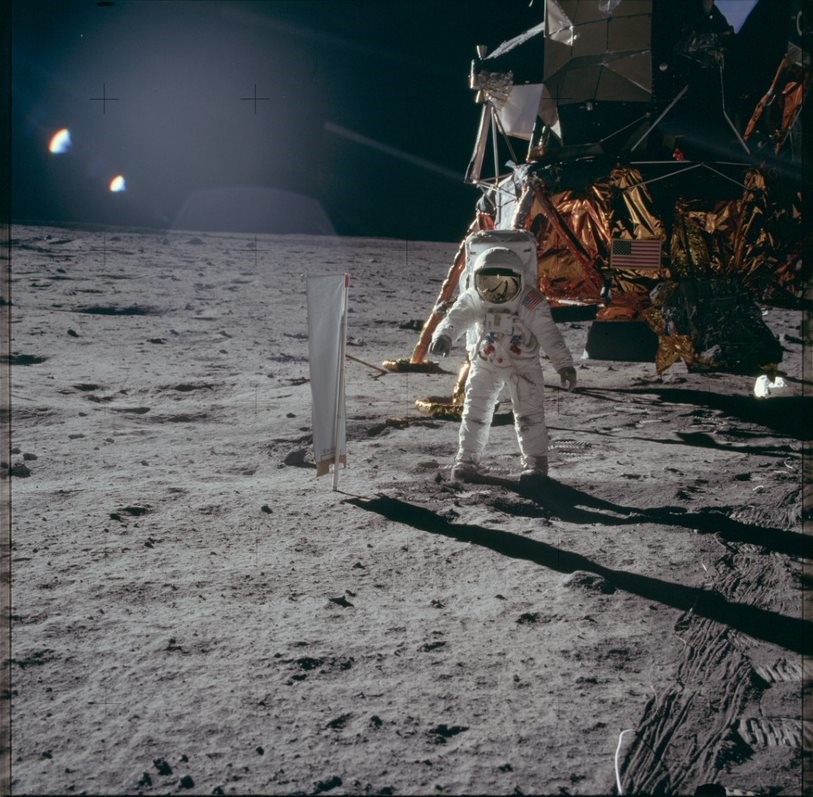
Saskatchewan's Apollo legacy
USask engineers made significant contributions to the NASA space program
By Chris PutnamThe Apollo 11 moon landing was an American initiative, but scientists and engineers from around the world made it possible—including some from Saskatchewan.
“It was a momentous occasion for all of humankind, and I think that’s something we should remember and look back on and commemorate,” said Rina Rast, a third-year student of physics in the College of Arts and Science.
Rast and fellow undergraduate physics student Brennan Rodgers are senior guides at the USask Observatory who helped organize a screening of the 2019 documentary film Apollo 11 at the facility to commemorate the mission and moon walk.
As they prepared for the anniversary event, the students researched the contributions made by USask alumni to the Apollo program—and were surprised by what they found.
“It kind of made me proud to think that I am studying at the same university that other people had studied at and then gone on to win awards with NASA. It was inspiring,” said Rast.
Rast and Rodgers came across names such as Douglas Tilden, a College of Engineering graduate (BE’53) who worked at Boeing on several of the vehicles involved in the race to the moon. Tilden received the Silver Snoopy award—the honour presented by NASA astronauts to employees who had an outstanding impact on flight safety or success—for his role on the lunar rover design and on the Apollo 15 mission.
Other crucial Apollo contributions were made by Dr. Edward J. Baldes (BA’18, PhD), one of the College of Arts and Science’s first 100 Alumni of Influence. As a researcher and later director of the Mayo Clinic, Baldes performed consulting work for the U.S. Air Force that led to the development of the lifesaving pressurized anti-gravity suit used by pilots in the Second World War. He invented the first human centrifuge, the famous spinning contraption used to assess and train Apollo astronauts.
Dr. Donald Shemansky (BE’58, MSc’60, PhD’66) held important roles at NASA in the years following the Apollo program. Shemansky was a co-investigator on multiple outer-planet exploration spacecraft missions and the recipient of 10 achievement awards from NASA.
“It’s exciting to hear about that kind of stuff. It really kind of hits home when you realize that’s here—that’s this university that’s contributing to this massive challenge on an international level. It’s really cool,” said Rodgers.
Rodgers said he was impressed to learn that the “prestigious tradition for space design and research” has continued at USask in the decades since the moon landings.
He points to the success of the University of Saskatchewan Space Design Team, the student group that has racked up a slate of international awards at space elevator and rover design competitions since 2005. The team is now working on building a cube satellite for the Canadian Space Agency.
Other USask alumni, such as Doug Campbell (BE’08, MEng’13, MSc’18) and Jason Leuschen(BE’00), have been shortlisted as astronaut candidates in recent years.
Although they were born decades after the moon landings, Rast and Rodgers both say that part of their motivation to study astronomy is owed to the Apollo program.
Rodgers remembers seeing the Apollo 8 image of Earth rising above the horizon of the moon on YouTube when he was in high school. “That was when I started to realize that there’s a hidden world of secrets and mysteries out there—that you just need to put in effort and try and figure it out,” he said.
Rast traces her fascination with space back to around Grade 10, when she picked out First Man: The Life of Neil A. Armstrong from a library. “I remember . . . reading it cover to cover and being absolutely astounded by what I read in it,” Rast said.
As part of their studies, the two students have been involved in exoplanet research, the emerging field of studying planets around other stars. They both hope to pursue graduate studies in astronomy after they complete their bachelor’s degrees.
“There’s a lot of discoveries that are just sitting out there waiting to be made. It’s a very exciting time to be doing astronomy,” said Rodgers.
Rast said she continues to be motivated by a quotation by Neil Armstrong. Asked why humankind should go to the moon, Armstrong said in 1969, “It’s in the nature of his deep inner soul. We're required to do these things just as salmon swim upstream.”
“Something that I’ve tried to take to heart in coming to university, trying to get my degree studying astronomy, is salmon swimming upstream—because it’s not always easy, but it’s worthwhile,” said Rast.
Chris Putnam is a communications officer in the USask College of Arts and Science.

